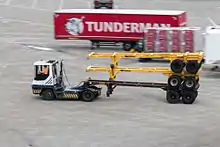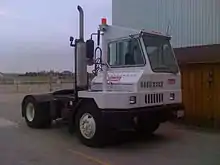Terminal tractor
A terminal tractor, known in the United States as a shunt truck, spotter truck, spotting tractor, yard truck, yard shifter, yard dog, yard goat, yard horse, yard bird, yard jockey, hostler, or mule, is a semi-tractor intended to move semi trailers within a cargo yard, warehouse facility, or intermodal facility, much like a switcher locomotive is used to position railcars.

A terminal tractor moving trailers in the Port of Rotterdam, the Netherlands

A terminal tractor
Characteristics
Distinctions between a terminal tractor and a regular road truck include:
- A single-person cab offset to the side of the engine.
- A full-height, sliding rear door for easy access to trailer connections.[1]
- A very short wheelbase, usually with a solidly mounted rear axle.
- A low-power diesel or alternative fuel engine, usually with an automatic transmission.
- A fifth-wheel coupling with an integrated lifting mechanism allows the semi-trailer's legs to remain in the lowered position during movement. 15 inches (380 mm) and 70,000 lb (32,000 kg) of hydraulic lift is typical.
- 12-gauge steel side wall cab construction with 1⁄2-inch (13 mm) steel floors for protection in abusive and dangerous work environments.[2]
- A rear window to create a 360-degree view
Since off-road versions do not have to drive on roads at highway speeds, a typical top speed is just 25 miles per hour (40 km/h).
See also
References
- http://www.autocartruck.com/terminal-tractor
- "Capacity Texas" (PDF). capacitytexas.com.
External links
| Wikimedia Commons has media related to Terminal tractors. |
This article is issued from Wikipedia. The text is licensed under Creative Commons - Attribution - Sharealike. Additional terms may apply for the media files.
